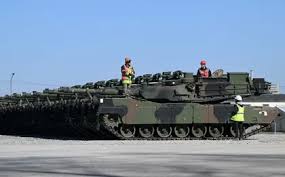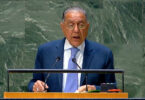STOCKHOLM (AFP): Global military expenditure saw its steepest increase in over a decade in 2023, reaching an all-time high of $2.4 trillion as wars and rising tensions fuelled spending across the world, researchers said on Monday.
Military spending rose across the globe with particularly large increases in Europe, the Middle East and Asia, according to a new report by the Stockholm International Peace Research Institute (SIPRI).
“Total military spending is at an all time high … and for the first time since 2009, we saw spending increase across all five geographical regions,” Nan Tian, a senior researcher at SIPRI, told AFP.
Military spending rose by 6.8 percent in 2023, the “steepest year-on-year increase since 2009,” according to the report.
“It’s a reflection of the deterioration of peace and security around the world. There’s really not a region in the world where things have gotten better,” Tian said.
The United States, China, Russia, India and Saudi Arabia were the top five spenders, respectively.
The continuation of the war in Ukraine led to an increase in spending by Ukraine, Russia and “a whole host” of European countries, Tian said.
Russia boosted spending by 24 percent, reaching $109 billion in 2023, according to SIPRI’s estimates.
Since 2014, when Russia annexed Ukraine’s Crimea, the country’s military spending has risen by 57 percent.
Limited room
Ukraine’s military spending rose by 51 percent, reaching $64.8 billion, but the country also received $35 billion in military aid, of which the majority came from the US, meaning the combined aid and spending equalled over nine tenths of Russia’s spending.
Tian noted that while Moscow’s and Kyiv’s overall budgets were relatively close in 2023, Ukraine’s military spending equalled 37 percent of its gross domestic product (GDP) and 58 percent of all government spending.
By contrast, in Russia, which has a larger economy, military spending amounted to just 5.9 percent of its GDP.
“So the room for Ukraine to increase its spending is now very limited,” Tian said.
In Europe, Poland saw the largest increase in military spending by far, up by 75 percent to $31.6 billion.
Spending also rose across the Middle East, where Israel – the region’s second-largest spender – saw a 24-percent increase, to $27.5 billion in 2023 – mainly driven by the country’s offensive in Gaza in response to the October 7 attack by Hamas.
Saudi Arabia, the Middle East’s largest spender, also upped its spending by 4.3 percent to an estimated $75.8 billion.
The US – which spends more on its military than any other nation – increased spending by 2.3 percent to $916 billion.
Worsening tensions
China boosted spending on its military for the 29th straight year, raising it by another six percent to an estimated $296 billion.
Beijing’s military build-up and worsening tensions in the region have prompted its neighbours to dedicate more funds to their militaries.
Japan spent $50.2 billion last year and Taiwan $16.6 billion, an increase of 11 percent for both countries.
The world’s fourth largest spender, India, meanwhile hiked spending by 4.3 percent, to $83.6 billion.
In Central America and the Caribbean, spending increases were instead driven by other struggles, such as fighting organised crime.
For instance, the Dominican Republic upped spending by 14 percent in response to worsening gang violence in neighbouring Haiti spilling over the border.
Africa also saw military budgets swell.
The Democratic Republic of Congo more than doubled its spending (+105 percent) to $794 million, the largest percentage increase of any nation, as tensions grew with neighbouring Rwanda.
With an increase of 78 percent, South Sudan saw the second-largest increase, to $1.1 billion.
With the war in Ukraine being “nowhere close to an end,” as well as the current situation in the Middle East and heightened tensions in Asia, Tian said he believed countries were likely to continue boosting their militaries.
“The expectation is that this increasing trend will continue for at least a few years to come,” he said.







